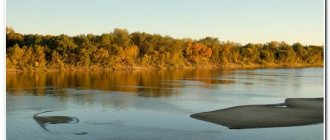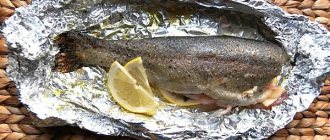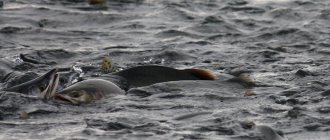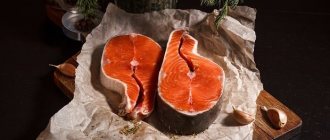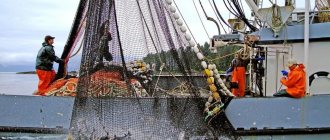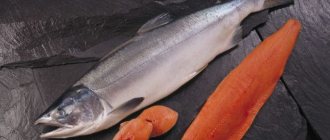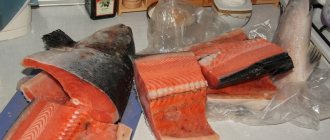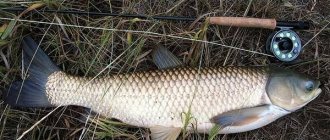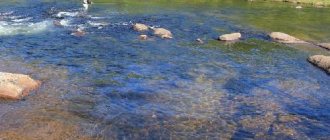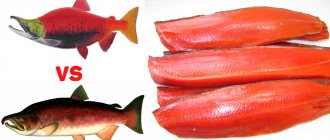Description and sizes of char
The char fish, the description of which is very different in different regions of Russia, has a great ability to change color. The natural forms of salmon also have different sizes.
The largest representative of the genus in our country is the kunja. The length of adult individuals reaches 80−100 cm and weighs more than 10 kg. But the Canadian lake form of char - gray trout - can grow up to 1.5 m. The average weight of such individuals is 25-30 kg. Other varieties of loach most often have an average body length of about 40−50 cm.
The appearance of loaches is characteristic of predatory fish: an elongated, well-streamlined torpedo-shaped body allows them to develop high speed while throwing. The dorsal fin is single; at the beginning of the caudal peduncle there is a small adipose fin.
Char scales are small and almost invisible. The dark back and light belly, small spots characteristic of many representatives, camouflage the predator. But during the spawning period, the color of the loaches becomes brighter, the belly acquires orange and red shades, and areas of different colors appear on the body.
Habitats
You can meet varieties of Arctic salmon in salt and fresh water bodies of the Northern Hemisphere: the Arctic and Pacific oceans, Siberian rivers, Lake Baikal, American and European waters. The southern border of the range in Russia is considered to be the latitude of the Krasnodar Territory.
Lifestyle and nutrition
All species lead a predatory lifestyle. Migratory species make seasonal feeding migrations, hunting small fish (capelin, navaga, blue whiting, etc.) in marine waters. The diet includes invertebrates that live in the bottom layers of water.
A feature of eating behavior is the ability to easily tolerate long-term fasting (up to 1 year). This makes repeated spawning possible, during which migratory forms rise into river beds.
Most often, loaches live alone or gather in small flocks - at a young age and during a sedentary existence in streams and lakes. Migratory forms during feeding lead an exclusively gregarious lifestyle, moving along the route in large schools, which include both young and adult individuals. Cannibalism is not developed, and small juveniles enjoy the protection of large specimens.
Where is loach found?
We looked through the fishermen's reports and marked on the map the best places to look for char.
Spawning
Loaches can spawn in both autumn and spring. Representatives of the spring race mature for spawning at the end of summer and immediately rise into the rivers, where they spawn. Winter char gather at river mouths, overwinter there under the ice, and in the spring continue their spawning migration up the riverbeds.
Spawning occurs on pebble shallows. The female buries the eggs in the ground, where they are incubated for 5-7 days. Loaches that spawn in the fall remain in rivers until spring, and then return to the sea. The winter form descends into the sea immediately after spawning.
The larvae remain motionless for about 5 days, and then begin to actively feed. They spend about 3 years in the river, reaching sexual maturity, and only then begin seasonal feeding and spawning migrations.
In sedentary forms living in fresh water, migration is practically not expressed.
Similar features
Of course, both species of salmon in question are very valuable commercial fish with approximately identical habitats and diets. Both chum salmon and sockeye salmon can live in both salt and fresh water. Unfortunately, after spawning in the latter they die.
Both types of salmon under consideration are a valuable source of unsaturated fatty acids and lecithin - a powerful weapon in the fight against atherosclerosis. With regular consumption of chum salmon or sockeye salmon, the likelihood of stroke and myocardial infarction is reduced to a minimum, bones are strengthened, and the functioning of the digestive tract is improved.
Varieties of char
On the territory of Russia, there are several main varieties of fish, differing in habitat, lifestyle, and appearance. They most often have a local name, and only the scientific name classifies them as different species of loach (Salvelinus).
Kunja
Due to its size (about 1 meter in length) and abundance, the species is a commercial fish of local importance. During the feeding period, kunja is caught industrially; during the rest of the period, it is the object of amateur and sport fishing. Large caviar females are valued not only for their tasty meat, but also for their red caviar.
The back of the kunja is dark, with a blue tint, the sides are brownish, with light spots, the belly is silver with a pinkish tint. You can meet char in the Pacific Ocean from Kamchatka to the Kuril Islands. The southern border of the range is the Amur River, into which the fish enters to spawn.
Far Eastern
Includes several local subspecies that live on the Kuril Islands and islands of the Russian Far East, in the Khabarovsk Territory and Primorye. Some species lead a sedentary lifestyle. A typical representative is the yellowmouth loach, or Levanidov's loach (Penzhina River).
The size of the fish rarely exceeds 50 cm. Far Eastern char is practically no different in taste from pink salmon. Caviar and milt are also obtained from sexually mature spawning individuals.
Local residents who are familiar with the char fish (the benefits and harms of where it is found) never refuse to buy or catch it.
White
Pacific variety, migratory during the spawning period. White loach is common in the Sea of Okhotsk and its surroundings. Sedentary subspecies are found in the rivers and lakes of Kamchatka. When doing amateur fishing, you need to take into account that parasites are found in white char more often than in other varieties.
The color consists of red spots on the background of the back and sides, the belly is silvery and pinkish. During the spawning period, the color becomes gray with a purple tint. The belly takes on rich shades of pink or yellow.
Ozerny
Lake char are sedentary varieties of native species. Lake fish can include Kamchatka char, representatives of European species from Lake Geneva, Ladoga or Baikal trout, and gray trout from Canadian lakes. The average length of lake char rarely exceeds 35−40 cm. This is explained by the lower availability of food in clean and cold reservoirs with limited volume.
Despite the differences from large migratory species, red char fish from lakes has the same pink meat with good taste characteristics.
Ruchevoy
The streams are also inhabited by local forms of loaches that have ceased migrating to the sea. These varieties are found everywhere where migratory species live: in the Far East, streams are inhabited by small varieties of Dolly Varden, and Kamchatka char has stream forms. An endemic species is found in Chukotka reservoirs - the Tarantsa char with pink spots on a silvery background of the body. European streams are inhabited by small subspecies of Arctic char, which share an ecological niche with trout.
Stream forms lead the lifestyle of an active predator, hunting small aquatic inhabitants.
Migratory char – habitat and lifestyle
The genus-forming taxon of the family is Salvelinus alpinus, which determines the size standards of this group of salmonids and serves as the basis for the formation of most lake, river, stream, and mixed forms. Officially, the fish is called Arctic salmon; it is a voracious predator and leads a migratory lifestyle, forming spring and winter races. The first ones carry out continuous migration, come to the river in the fall with already mature sexual products and immediately go to spawning grounds. The second ones interrupt migration. The fish enter the mouth before freeze-up and overwinter at depth in a state of rest, waiting for the final ripening of eggs and milt. Only in the spring do they resume moving upstream to their spawning grounds.
To learn more:
Taimen: a valuable fish of the salmon family
The selective migration instinct, fixed at the genetic level in each group of salmon, contributes to the stable replenishment of the species’ population twice a year, regardless of the timing of spring and other natural factors.
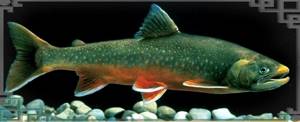
Habitats
The range of Arctic char is very wide - it includes salt and freshwater waters of the Pacific and Arctic oceans south and north of the Arctic Circle. The fish lives off the coast, in rivers and lakes of Norway, Iceland, the Spitsbergen archipelago, Greenland, Canada, and Alaska. In Russia, char inhabits the Arkhangelsk, Murmansk regions, Primorsky, Krasnodar Territories, the Komi Republic, the Kola Peninsula, the Novaya Zemlya archipelago, Sakhalin, Kamchatka, the Kuril Islands, the coast of Siberia, the Amur and Baikal basins. The favorite feeding area for migratory salmon is the shelf of the Barents, Kara, Japanese, White, and Okhotsk seas. Most often, the char is found in the main channel and tributaries of the Ob, Pyasina, Yenisei, Ponoya, Varzuga, and Kara.
Lifestyle and nutrition
Migratory fish are very unpretentious to food, low temperatures, and water salinity levels. At the age of 2-4 years, salmon begins to make summer food migrations to the sea, where it takes on the role of an active predator, hunting small cod, capelin, pollock, blue whiting, navaga, and sand lance. The fish willingly eats a variety of crustaceans, mollusks, worms, and small sea creatures.
The lifespan of Arctic char, like most of its other forms, can reach 11-12 years. As the fish grow older and gain mass, they gradually abandon schooling behavior in rivers, preferring to stay in small groups or switch to solitary living if there is a significant shortage of food supply. When salmon go out to feed at sea for several months, they again gather in large schools without any age or size division. This facilitates collective hunting for small schooling fish and saves them from larger predators. Due to the fact that young animals enjoy the protection of adults, the survival rate of the entire species increases significantly.
To learn more:
Omul: where the fish are found, what they eat and how they spawn
Despite their gluttony and constant search for food, loaches can go without eating for a whole year without damage to their health and weight. This was made possible due to a special biological mechanism for regulating metabolism and the size of the intestine. Largely due to the ability to forcibly free up additional space in the peritoneum, this genus of salmon easily endures the spawning process without the slightest damage to health.
In close relatives of char (pink salmon, chum salmon, chinook salmon), sufficient space for caviar and milt is formed due to fatal deformation of the intestines and other internal organs. That is why, after the end of migration to the spawning ground, the fish stop feeding, lose strength and die en masse.
Beneficial features
No matter where the fish lives, it is always useful. Salmon meat contains many vitamins, important microelements (zinc, phosphorus, calcium), balanced potassium and magnesium. In combination with omega fatty acids, they have a positive effect on the condition of the human heart muscle.
The delicate consistency of char meat allows you to use any method of preparing it. Char can be fried and baked, cooked into fish soup and other soups, and steamed. Smoked and lightly salted fish are delicious options, and red caviar is not too different from salmon.
Brook char
The high morphological, ecological, and climatic variability of the Arctic taxon, combined with vitality and unpretentiousness, led to the formation of various river forms that swim in running water all their lives. In the Primorsky Territory and the Kuril Islands, beautiful small Dolly Varden, covered with variegated red spots, lives. It rarely grows in length over 30 cm, and its lifestyle is similar to brook trout.
To learn more:
Description of the trout fish - how is it useful?
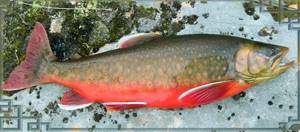
The Tarantsa loach (Salvelinus Taranetzi) lives in Chukotka; it has a silver-gray body with large pink spots and can reach a weight of 10-12 kg. This species is characterized by slow growth. Often individuals over 15 years old weigh only 3-4 kg. This is primarily due to the lack of nutritious food supply. Kamchatka char is also presented in stream forms, which are characterized by regular entry into lakes for feeding and relatively small sizes in the range of 1.5-2 kg.
We help you make the right choice!
2020-02-28 09:45:09
| Tests and research | Good to know | Let's be honest about milk | Quality mark | Payment |
| All tests: A-Z |
| Sections |
| Nutrition |
| Children's |
| Health/Cosmetics |
| Auto/Velo |
| Electrical engineering |
| Construction |
| Manufactured goods |
| Services |
Chum salmon
(Oncorhynchus keta)
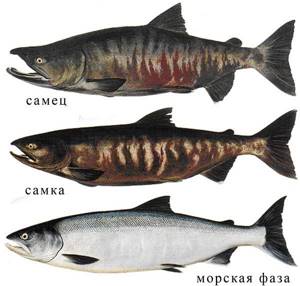
The spawning run into the rivers of northern Primorye begins in August, and the mass entry and spawning begins in the second half of September - October at a water temperature in the rivers of 5 - 10 0 C. In southern Primorye, the entry into the rivers and spawning of chum salmon occurs at a later date. Spawning grounds in the rivers of Primorye are usually located in the lower reaches or middle reaches. Spawning occurs in areas with weak currents, the bottom of which is covered with small pebbles and gravel. Some fish spawn in lower channels fed by groundwater. The eggs are laid in the mounds. After laying eggs, exhausted fish die. The larvae hatch in the spring and, unlike juvenile masu salmon, they do not linger in the river and immediately roll into the sea. In the first summer, the hatched juveniles live in coastal waters, bays and bays, and only later migrate to the open waters of the sea and the Pacific Ocean.
Char fish: harm and contraindications
Despite the large number of positive factors, it is better to avoid eating this fish if:
- Individual intolerance and allergic reaction (redness or rash on the body).
- If you are not sure about the quality of char, then avoid eating such a product to avoid food poisoning.
- The salmon family is in second place in the contamination of meat with parasites (tapeworms and roundworms). This only applies to fish caught in wild waters. Meat infected with parasites contains small larvae the size of a grain of rice, which, when they enter the human body, develop into a mature individual.
Note! It is strictly prohibited to consume such a product in its raw form! The larvae die during heat treatment within 15-20 minutes after boiling.
Source
More articles from the section “Benefits and harms of products”
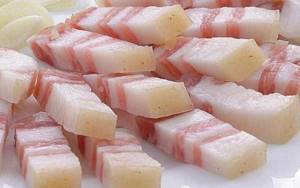
The benefits and harms of lard, composition, how many calories
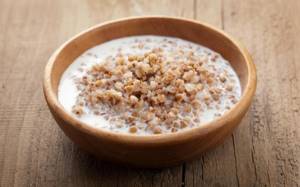
Buckwheat with kefir in the morning on an empty stomach - benefits and harms, recipe

The benefits and harms of olives, calorie content
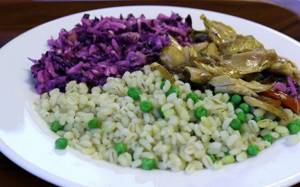
How barley is useful and who it is contraindicated for, how many calories it contains
What kind of fish
Char is a predatory representative of the salmon family. Found in mountain lakes and rivers. It also lives in the seas, but does not swim far from fresh waters, where it spawns. It feeds on plankton, caviar, small fish, crustaceans, and mollusks. Some individuals eat their own young. Loaches hunt day and night.
There are several dozen subspecies of this fish, differing in geography and appearance. Their general characteristics:
- Torpedo-shaped body.
- Flattened head.
- There are no large scales.
- The back and sides are grayish-blue or brownish-green.
- Reddish belly, becoming brighter during spawning.
- A strong backbone with long bones (almost no small bones).
- The meat is red-orange.
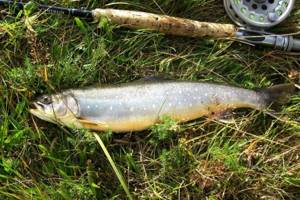
Loaches are divided into several forms:
- nautical. It lives off the coast of the Atlantic, Pacific and Arctic oceans, and swims to river mouths to breed;
- river. Looks like a trout;
- lake Often found in mountain reservoirs. Due to the lack of a large amount of food, its length does not exceed 40 cm.
Among the subspecies of fish, the most famous are:
- Far Eastern. Size up to 50 cm, tastes like pink salmon. Distributed in the Kuril Islands, Primorye, Amur Region, Khabarovsk Territory.
- White or Kamchatka. It is distinguished by the presence of many light spots on the body. The main population lives in Kamchatka.
- Arctic. It can reach a weight of about 15 kg.
- Boganidsky or Bogandinsky. Found in Siberia in reservoirs with a good supply of oxygen. In lakes of Karelia it reaches 80 cm in length.
Popular species of migratory char
In addition to Arctic salmon, its Pacific form, Dolly Varden, which is classified as a separate species Salvelinus malma, is of great commercial importance. This fish is an important commercial object; it grows up to 3.0-3.5 kg with a body length of 70-75 cm and spawns exclusively in the fall. Going to sea to feed begins in early spring. The return to the river mouths coincides with the spawning process, after which Dolly Varden feeds for some time on insects, worms, bottom organisms, fry, and fish eggs, and then goes to the depths to rest.
Other common names for the taxon are Pacific, or white, char, for its numerous light spots on its sides, and bull trout, for its tall, flattened body and red fins.
Kunja
This large representative of salmon is capable of reaching a weight of 10-11 kg with a height of over 80 cm. But usually standard catches contain individuals weighing 1.0-3.0 kg (35-60 cm). Due to the characteristics of its habitat and abundance in the basins of the Okhotsk and Bering Seas, this species is often called Kamchatka char (Salvelinus leucomaenis), although the peninsula is also home to Dolly Varden and several other local salmon taxa.
Based on its behavior, the kunja should be classified as a very aggressive predator that prefers to eat other fish, including fry (pied fish) and young salmon of any species. During the marine feeding period, Kamchatka char prefers not to move away from the coast and estuarine areas, making short feeding migrations in search of schools of smallmouth smelt, gobies, sand lance, and herring.
Far Eastern char
This is the collective name of several subspecies with a habitat on Sakhalin, Shantar, Kuril Islands, Kamchatka, Primorsky, Khabarovsk Territories, Amur Region. The most famous taxon is Levanidov's loach (Salvelinus levanidovi), which lives in the river. Penzhin. For the picturesque yellow spots on its body, it received the nickname “schisandra.” The bright coloring of the mouth gave it another common name - yellow-mouthed golodets.
To learn more:
Chinook salmon: a unique fish of the salmon family
Not all representatives of salmon have a genetic predisposition to feeding migrations to the sea and subsequent return to rivers for wintering. Some species forms are born, reproduce and constantly live in fresh water bodies.
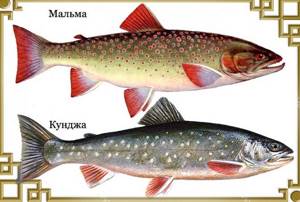
Beneficial features
Red char fish is valued by culinary specialists for its good taste, and doctors often include it in the medical menu. The main list of benefits of char:
Reduces the risk of blood clots. Clears the body of cholesterol. Strengthens blood vessels. Has a beneficial effect on brain function. Increases the body's resistance to infections. Prevents early skin aging and cell destruction. Reduces the likelihood of developing tumors. Improves reproductive functions, increases potency. Normalizes the functioning of the gastrointestinal tract. Reduces nervousness. Saturates the body with calcium. Prevents the development of ophthalmological problems.
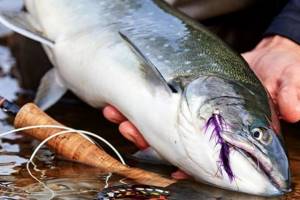
Contraindications and possible harm
There are no direct contraindications to consuming char. However, red fish is a potential allergen. People with seafood intolerance should avoid this type of food.
If the rules for preparing and selecting a product are not followed, char can be not only beneficial, but also harmful. The consumer needs to consider the following:
Stale fish causes food poisoning. Char caught in the wild can be infected with helminths. The meat must be subjected to good heat treatment. When frying, the fillet loses some of its beneficial properties, becomes more nutritious, and absorbs harmful cholesterol.
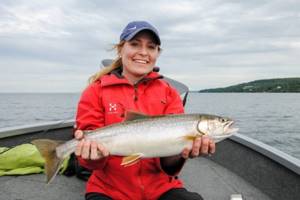
How to choose and how long to store
When purchasing frozen or chilled char, you need to pay attention to the following:
- A high-quality carcass should be free of creases and cracks. If the fish's tail is broken off or dried out, it is not fresh.
- The fish should be silver in color with spots on the sides. The fins should be intact and pressed to the body.
- Chilled fish should not leave any dents when pressed.
- The eyes of fresh fish are transparent, without a white film.
- The color of the gills of fresh fish is always pink. Brown or gray gills indicate that the product is spoiled.
It is advisable to cook fresh fish immediately, maximum 4 hours after purchase. The frozen product is stored in the freezer at a temperature of -18 degrees. Shelf life up to 7 months.
Benefits and harms in diseases
Depending on the disease, experts indicate some features of the impact of char on health:
- hypertension. Fish is rich in substances that help normalize blood pressure. People suffering from pathology are advised to eat 100 g of the product daily;
- pancreatitis. In case of chronic disease in remission, fish helps restore the balance of vitamins and minerals. During an exacerbation, char is prohibited;
- thrombosis. Only properly prepared products are allowed: steamed, grilled, baked in the oven;
- osteoporosis. Red fish - contains substances that promote the accumulation and absorption of calcium. It is advisable for patients to eat char daily.
Fish habitats
When talking about trout, people often combine any species of fish belonging to the salmon family and living in freshwater bodies. In fact, this group includes many species. These are char fish, characterized by their small size, chum salmon, and chinook salmon.
The habitats of coho salmon may vary depending on the specific species. The Japanese and Americans call it Silver Salmon. In Asia, or more precisely, in the Anadyr River, other species live. Sometimes you can find such fish in Hokkaido. Far Eastern coho salmon are found in Kamchatka.
Another species is concentrated in large numbers near the coast of North America on the Pacific Ocean. Here it can be found from the coast of California all the way to Alaska. North American coho salmon, which live near the North American continent, are much larger in size compared to their Asian counterparts.
Coho salmon spawn in their fourth year of life. Freshwater species are ready to reproduce already in the third year of life. Coho salmon move to freshwater bodies in early summer. Spawning continues until December. Depending on the timing of spawning, this fish can be divided into several varieties . These are summer, autumn and winter species of coho salmon.
Summer hybrids spawn in August. Autumn ones begin breeding in mid-autumn, and winter ones - in early January. You will never see coho salmon in the lakes during the spawning period. During this period it is always present in rivers.
Sockeye salmon most often lives in various parts of Kamchatka. Also her favorite territories are:
- Alaska,
- rivers Tauy and Okhota.
To catch sockeye salmon, standard amateur gear is used. But in order to go hunting for this predator, you must obtain appropriate permission from government authorities . In recent years, uncontrolled fishing of this fish has led to a decline in its population.
Recommendations from nutritionists for losing weight
Nutritionists recommend including red fish in your diet. It is fattier than hake or halibut, but contains more amino acids. If a person has a choice between salmon, salmon or char, it is better to take the latter. Its calorie content is lower than that of the listed varieties. When losing weight, you need to follow several rules:
- Steam, bake, boil fish.
- If you are overweight, eat the product 1-2 times a week, 100 g.
- After eliminating extra pounds, you can use it more often.
- Avoid smoked, salted, and oil-fried fish.
Cooking methods
Char is a versatile fish. It turns out incredibly tasty any way you cook it.
How to bake whole in the oven?
Oven-baked char has a pleasant aroma and a very tasty fried crust. To prepare, the fish is cut, rubbed with spices, coated with sour cream or butter. Next, put it in foil, and sprinkle onion, garlic or lemon on top - it all depends on personal preference. After pinching the foil on all sides, the loaches are placed in an oven preheated to 200 °C. It takes about 30-35 minutes to bake the fish until it is fully cooked. For those who want to enjoy an appetizing crispy crust, it is recommended to open the top of the foil 5-10 minutes before the end of cooking.
To get a complete dish for the table, you can add vegetables or potatoes to the fish in foil.
How to fry in a frying pan?
For frying, the char is pre-cut, cut into small pieces, or a whole fillet is taken for frying. The fish is coated with salt and spices, and then, if desired, dipped in crackers or batter. The next step is to pour a little vegetable oil into the frying pan and, after heating it, lower the fish into it. Fry the char for several minutes on all sides.
How to steam?
Steamed char will be useful for people who follow a healthy diet, those on a diet and those who simply do not like heavy fried food.
To prepare steamed fish, you will need a steamer or multicooker. Peeled and cut into pieces, the loach is coated with salt and spices to taste, and then placed in the bowl of the kitchen device. The fish is cooked for 20 minutes.
Those who do not have a modern appliance should not despair; you can steam fish the old-fashioned way - in a water bath. To do this, pour water into the pan, and place an iron colander on top so that it does not touch the water. Place the fish in a colander, place the pan on the water and boil. The resulting steam will be enough to cook the dish.
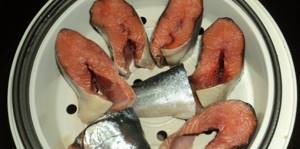
How to salt fish?
The best way to prepare it is to salt the char using the dry salting method. To do this, the fish is pre-washed and wiped dry. In a separate bowl, mix salt and sugar in a 2:1 ratio, respectively. Part of the mixture is poured into a deep salting container, then chopped pieces of fish are laid out and the remaining amount of salt and sugar is added. Char is salted at the rate of 100 g of bulk mixture per 1 kg of fish. The container with the product is placed in the refrigerator overnight.
The next day, the fish is taken out, shaken off the salt, washed and dried. Next comes the second stage of salting: the loach is rubbed with ground black pepper, placed in a deep container, and chopped pepper is placed on top of the fish. After 2 hours in the refrigerator, the char will be ready to eat.
How to smoke?
There are two ways to smoke char – cold and hot smoking.
Hot way
To prepare hot smoking, the loach is initially cut and dried. Afterwards, the fish is immersed in a special marinade for 8 hours. It is prepared like this: a glass of soy sauce is mixed with a glass of semi-sweet wine, lemon juice and spices to taste. The marinade is boiled, poured over the fish and placed in the refrigerator.
After marinating, the carcasses are hung out for several hours to dry. The next step is to place the fish on the pre-oiled smokehouse grates. The smokehouse is covered with a lid and placed on a grill, stove or other fire source. At a temperature of 80-110 °C, the fish is cooked for about half an hour.
Cold way
The technology for preparing char in a cold way is as follows:
- Mix a liter of water, 2 pcs. bay leaf, 4 tbsp. salt, 3 cloves, several peas each of allspice and black pepper.
- The resulting mixture is poured into a saucepan and brought to a boil. Add lemon juice.
- Place the fish in a container, fill it with chilled brine and, having installed the press, put it in the refrigerator for a day.
- Every other day, the fish is taken out and thoroughly dried.
- Fish carcasses are hung outside for a day, tail down, to dry completely.
- The fish is placed on the grates in the smokehouse, the wood chips are set on fire and the smoking process begins.
Cold smoking requires constant maintenance of a temperature not exceeding 30 °C. Cooking time depends on the size of the carcass. It can vary from 8 hours to one and a half days.
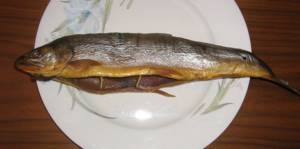
How to cook on the barbecue and grill?
Cooking fish on the grill and on the grill have similarities. The loaches are first cleaned, gutted, and coated with salt, pepper and other spices. Next, the carcasses are placed on a grill or grill and fried on each side for 7-10 minutes.
Nutritional value, calorie content
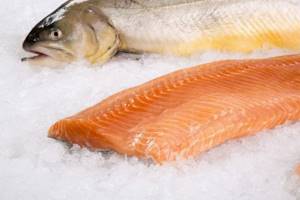
Vitamins:
- choline (B4) – 64.7 mg;
- niacin (PP) – 2.92 mg;
- pantothenic acid (B5) – 0.75 mg;
- pyridoxine (B6) – 0.28 mg;
- thiamine (B1) – 0.14 mg;
- tocopherol (E) – 0.18 mg;
- riboflavin (B2) – 0.12 mg;
- retinol (A) – 35.45 mcg;
- folic acid (B9) – 14.98 mcg;
- cobalamins (B12) – 0.97 mcg;
- phylloquinone (K) – 0.098 mcg.
Minerals:
- potassium – 316.577 mg;
- phosphorus – 269.1 mg;
- sodium – 50.91 mg;
- magnesium – 34.416 mg;
- calcium – 25.66 mg;
- zinc – 0.99 mg;
- iron – 0.37 mg;
- manganese – 0.066 mg;
- copper – 71.61 mcg;
- selenium – 12.71 mcg.
100 g of raw char – 134.761 kcal.
Calorie table for different cooking methods
| Salmonids | |
| Family SALMONID (Salmonidae) Much more well-known and popular are such collective names as salmon and trout. In fact, the salmon family consists of the following fish:
| |
| Salmon family | Description |
| One of the most widespread representatives of Pacific salmon. In Primorye it is found everywhere from the Tumannaya River to the north-eastern coast, into the rivers of which (Edinka, Kabanya and others) in recent years chum salmon, after a long break, regularly enters to breed. The general range covers the entire northern Pacific Ocean. | |
| Representatives of this species reach 80 cm in length and weigh up to 3 kg. Sockeye salmon resembles chum salmon in size and body shape; the easiest way to distinguish these species is by the number of gill rakers on the first gill arch: chum salmon have from 18 to 28, and sockeye salmon always have more than 30. They most often become sexually mature at 5-6 years life. | |
| It is distinguished by small scales. In the sea, its body is painted silver, and there are many small dark spots on the caudal fin. | Salmon has bright silvery scales, among which, above the lateral line, are scattered several x-shaped dark spots. Her back is adorned with a royal shimmer of blue and silver. |
| common name for several species of fish. Establishing species is extremely difficult due to their proximity to each other and the existence of many varieties. Therefore, the species independence of trout has often been questioned: thus, true or river trout (S. fario) is often considered identical with lake trout (S. lacustris). | |
| The most ancient species of Pacific salmon. It is closest to the ancestor of the entire genus - the rainbow trout or some similar fish. | |
| large fish, reaches a length of 98 cm, weight 14 kg. It differs from other salmon in the bright silver color of its scales (hence the Japanese and American names “silver salmon” and “white fish”). | |
| a genus of large salmon fish. Small specimens have 8-10 dark transverse stripes on the sides of the body; small x-shaped and semilunar dark spots are common. During spawning, the body is copper-red. Widely distributed in almost all large rivers and lakes of Siberia and the Far East, also in Altai, for example: in the Bukhtarma and Kurchum rivers. Like other salmon, taimen is a predator, reaching 1 m or more in length and 60 kg in weight. | |
| They differ from other salmonids by having very small scales. The fish appears naked to the touch, hence its name. About 10 species of loaches are found in the Magadan and Kamchatka regions. The easiest way to distinguish them is by the color of mature individuals, which is especially pronounced during the spawning period. Loaches spawn several times during their lives; After each spawning, some of the fish die. Migratory char spend the winter in fresh water and annually go out to sea to feed; resident char constantly live in rivers and lakes. Some species (for example, Dolly Varden and Kundzha) are distinguished by great ecological plasticity and form anadromous and residential (freshwater) herds, among which there are river, lake-river, lake and dwarf stream herds. Some species of loaches, for example all palia, live only in lakes and never enter rivers and streams; their entire life cycle (including spawning) takes place in stagnant water. |
a brief description of
Char is widespread in nature. It is found in many countries, inhabiting rivers and other bodies of water. Catching this type of fish has made it possible for the population to consume expensive red fish.
What does it look like?
You can recognize a loach by its appearance. It looks like this:
- the elongated body of the loach has a specific torpedo-shaped shape;
- the body is covered with small, tightly fitting scales;
- there are bulging eyes on the large head;
- caudal fin noticeably truncated;
- the whole body is covered with many dark, pink or light spots.
This fish is a relative of salmon species. The loach has a dark body color. The meat of this fish is colored red.
Dimensions and weight
Char is considered a fairly large fish. For example, the Arctic species reaches 88 cm in length and gains weight up to 16 kg. Lake and river fish are smaller. They do not grow more than 45 cm in length, and the average weight ranges from 0.3-1.5 kg.
Where is it found?
Dried, smoked char
It is not advisable to dry red meat, since the cooking method deprives the product of its unique taste characteristics. Smoked char is considered a delicacy. When processed hot or cold, it retains its tenderness and attractive color.
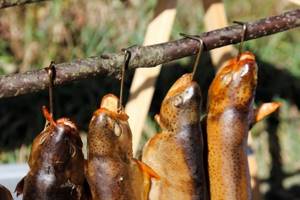
However, eating fish in this form is dangerous:
- Artificial colors and flavors are often used in cooking. In addition, during the smoking process, a large number of carcinogens are formed, which contribute to the formation of cancer cells.
- A hot smoked product loses some of its beneficial elements.
- A piece of such fish contains more calories than boiled, steamed, grilled or oven-baked fish.
Char as an alternative to pink salmon
Char and pink salmon have many similar characteristics due to the fact that they belong to the same family. This is expressed in almost the same calorie content and similar chemical composition of the meat of both fish, as well as a set of useful micro- and macroelements.
As valuable breeds of fish, pink salmon and char have so-called red meat, which is dietary and is used to prepare delicacies. The meat contains only a large backbone and long rib bones, which are easily removed.
Methods of preparing fish are also common: stewing, frying, baking, salting, preparing soup from the product. It should be remembered that salmon are in 2nd place for infection with tapeworms and other parasites. Therefore, pink salmon and char must be heat treated for at least 15-20 minutes. How to cook char fish
What products does it combine with?
Char is best paired with vegetables. Those who like to experiment should take into account that the simultaneous consumption of incompatible ingredients leads to digestive disorders and reduced absorption of nutrients.
| Treatment | Kcal per 100 g |
| Frying | 194,31 |
| Smoking | 144,7 |
| Pickling | 136,51 |
| Cooking | 134,1 |
| Extinguishing | 133, 21 |
| Baking in the oven | 133,12 |
| For a couple | 132,47 |
| Caviar | 134,8 |
Compatibility table with other products
| Fine | Ghee, whey, greens, cabbage, carrots, beets, pickles, green vegetables |
| Acceptable | Rice, buckwheat, lemon, quinoa, tomatoes, butter, vegetable oil, pumpkin, eggplant, zucchini |
| Badly | Meat, poultry, eggs, mushrooms, cream, sour cream, lard, nuts, seeds, potatoes, dairy products, cheeses, feta cheese, wheat, rye, oats, bread, peas, chickpeas, mung beans, beans, beans, lentils, |
Composition of char fish
The meat is very tasty and contains a rich chemical composition. Vitamins can be distinguished - Vitamin A (36 mg.), Vitamins B1 (0.14 mg.), B2 (0.12 mg.), B6 (0.3 mg.), B9 (15 mg.), B12 ( 1 mg.), Vitamin E (1 mg.), Vitamin PP (3 mg.) and Vitamin K (0.1 mg.) per 100 g. product.
Of the microelements I would like to note - Phosphorus (270 mg.), Potassium (317 mg.), Sodium (51 mg.), Magnesium (33 mg.), Calcium (26 mg.), Copper (72 mg.), Selenium (12 .6 mg.). As well as fatty acids important for the human body - Omega 3.
Cooking secrets
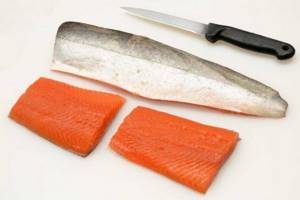
When defrosting, you need to take into account a number of features:
- the fish does not lose excess water if the process takes place slowly in the refrigerator;
- to preserve natural moisture, you need to cover the carcass with plastic wrap;
- Do not defrost fish in the microwave, expose it to contrasting temperatures, or bend it.
Cutting rules:
- Use a knife to remove small scales from the carcass.
- Remove fins and gills.
- When ripping open the belly, make a shallow incision from head to tail without damaging the gall bladder.
- To remove the backbone and bones, it is better to cut the carcass half-thawed.
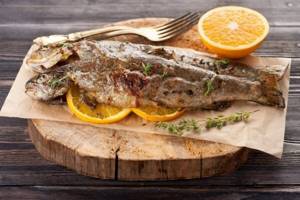
You can cook many dishes from char in a frying pan, in a slow cooker, or in the oven. Several recipes are offered to the reader's attention.
Char baked in foil with vegetables
Compound:
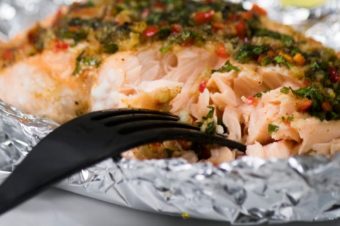
- 2 medium fish carcasses;
- 1 small carrot;
- 2 tomatoes;
- 1 sweet pepper;
- several sprigs of parsley;
- 2 tbsp. spoons of olive oil;
- a pinch of Italian herbs;
- 0.5 lemon;
- salt to taste.
- For the sauce, mix herbs, salt, olive oil, lemon juice.
- Cut the fish into medium pieces, vegetables into rings or half rings.
- Make bags out of foil and fill them in the following order: carrots, tomatoes, peppers, herbs, char.
- Pour the sauce over the dish, seal with foil, and place in the oven.
- Bake at 180 - 200 degrees for 30 - 40 minutes.
Char pie
Ingredients:
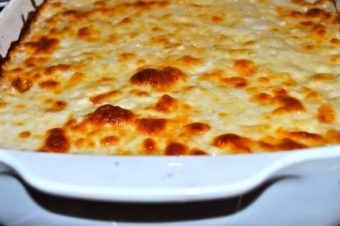
- 500 g puff pastry;
- 800 g fish fillet;
- 2 onions;
- 3 chicken eggs;
- spices and salt to taste.
- Boil the eggs and cut into cubes.
- Divide the fillet into medium pieces, the onion into half rings, mix, fry and cool.
- Place half of the dough on a baking sheet, fill with filling: 1st layer - eggs, 2nd - fish with onions.
- Cover the pie with the remaining dough and pinch the edges.
- Bake until golden brown at 190 degrees.
Compound:
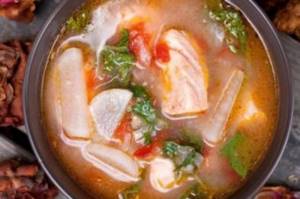
- 1 fish carcass without entrails;
- 2 units each tomato and potato;
- 1 medium onion and 1 carrot each;
- 3 liters of water;
- salt to taste, spices, herbs.
- Place the loach in cold liquid.
- Bring to a boil, add salt and collect foam.
- Boil for 15 - 20 minutes, remove the fish.
- Add chopped vegetables and spices to the broth.
- Bring the potatoes until cooked and add the char meat separated from the bones, cook for 1 - 2 minutes.
- Sprinkle with herbs before serving.
How to salt fish at home
Only fish that has not been frozen should be salted. According to housewives, char cooked according to the following recipe turns out delicious:
- Divide the fish lengthwise into two parts.
- Mix salt and sugar 2:1 (1 kg of raw materials – 100 g of dry marinade).
- In a deep container, mix the carcass with the prepared mixture.
- Close the container tightly and put it in the refrigerator.
- After 12 hours, shake the fish to remove excess marinade and leave for another 12 hours.
- Before serving, cut into slices and sprinkle with spices or herbs.
How to clean and cut?
Housewives love char for its minimal amount of scales. Some species, such as Kamchatka char, do not require cleaning at all. It is enough to cut it up and get a thin-skinned fish fillet, ready for cooking. For those fish that have visible scales, it would be useful to run a knife against the scales throughout the body, cutting them off completely.
Fish cutting occurs in several stages:
- By making two cuts at an angle, the head is separated.
- With a single movement of the knife, a straight cut is made from the head to the tail to rip open the belly.
- Internal organs are removed.
- Divide the fish into 2 equal parts, cutting the body along the ridge.
- The side fins and bones are removed.
- Cut the loach into pieces of the desired size.
